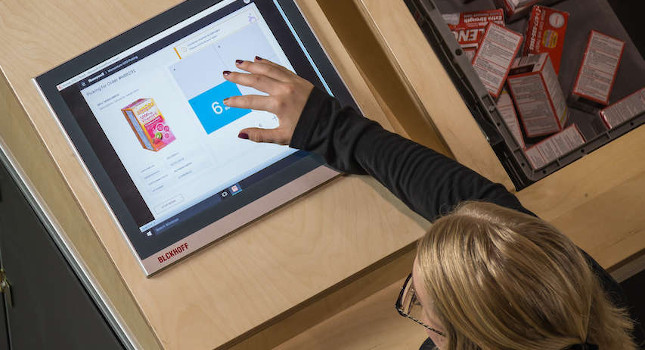Connected distribution center takes control of intralogistics challenges
Cover Story: A connected distribution center boosts device connectivity and networking capabilities with PC control and EtherCAT while cutting controller hardware costs by 50%.
Learning Objectives
- An e-commerce distributor used EtherCAT- and PC-based automation to improve operations due to labor shortages.
- This allowed the company to connect current and legacy equipment and reduce strains on overall bandwidth.
- The solution provided savings for hardware, software and overall equipment costs.
E-commerce continues to grow at a 25% annual rate, according to Honeywell Intelligrated. There’s a catch to this growth, though: For every six jobs created, there is only one worker available and only 20% of candidates possess the necessary skills. These statistics underscore the labor challenges facing retailers and distribution centers (DCs) in a hyper-competitive market. For these reasons, many intralogistics operations are leveraging technological advances to accelerate their digital transformations and maximize DC efficiency and productivity.
A connected distribution center platform combines asset monitoring, warehouse execution and labor management software with advanced automation and robotic solutions to help resolve the skills gap.
“The purpose of our connected suite is to aggregate data in real time to optimize worker productivity, improve operational reliability and streamline performance through automation. In doing so, we’re connecting people, equipment and automation systems to key performance indicators (KPIs) such as uptime, throughput and profitability,” said Joe Joice, VP of business development for Honeywell Intelligrated, a system integrator and machine builder.
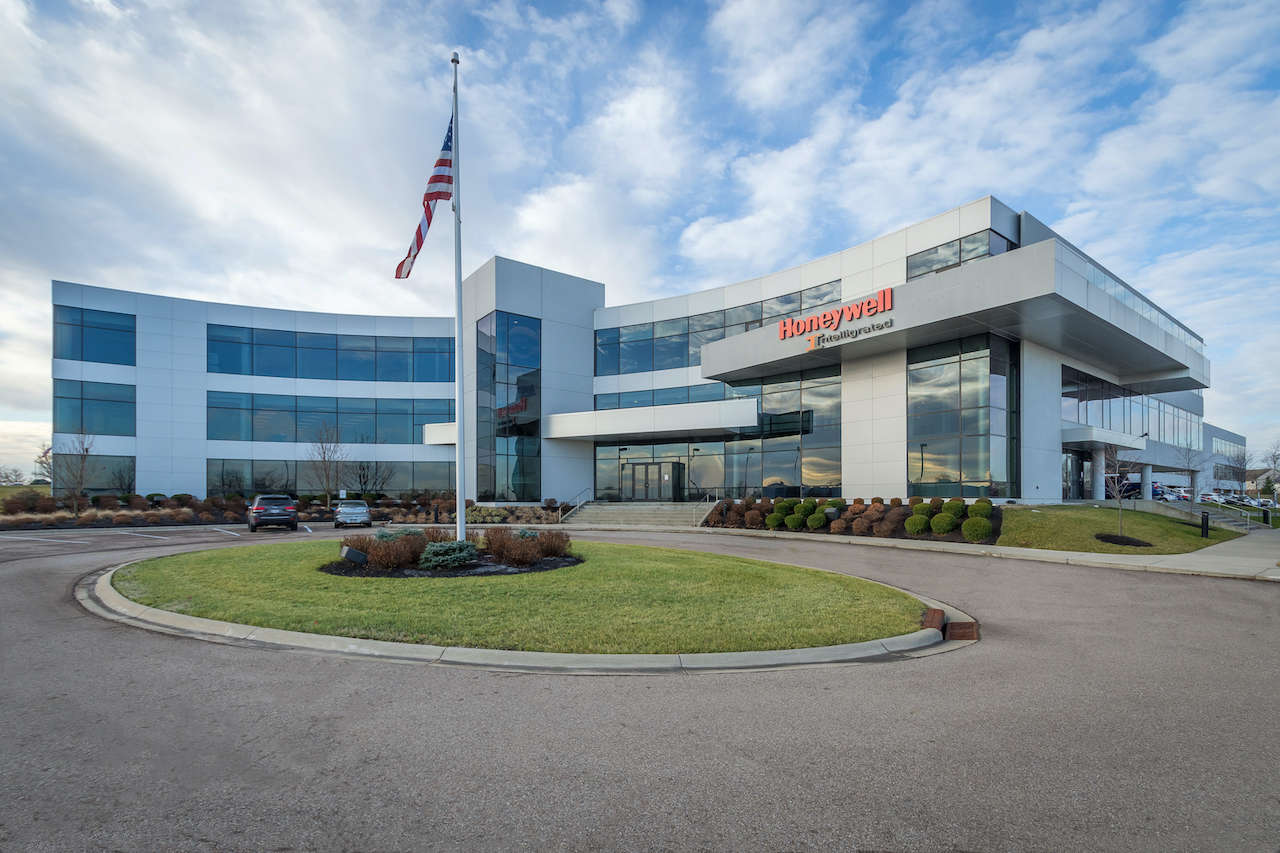
The U.S. headquarters for Honeywell Intelligrated is located in Mason, Ohio, with branches in Owings Mills, Maryland, and elsewhere. Courtesy: Beckhoff
The concept of a connected distribution center is the driving force behind the development of all automation and material handling solutions – from software to conveying and sortation equipment. Recent examples include the modular goods-to-robot (GTR) and goods-to-operator (GTO) workstations as well as a fourth-generation PC-based machine control platform.
“Compared to legacy platforms, [the new PC-based architecture] allows us to design in functionality that customers want, including focused and intentional data acquisition,” said Jason Johnson, senior manager of machine control development, Honeywell Intelligrated.
Both systems’ capabilities draw on the advances of robotics and a broad range of shuttle, palletizing and gapping solutions. Implementing a connected infrastructure across a conglomerate with multiple product families was no small task. To strengthen DCs facing labor shortages and increasing e-commerce technology demands, EtherCAT- and PC-based automation were being used.
Robots lend a hand in fulfillment centers
GTR workstations improve fulfillment operations for companies across multiple industries. Applications range from DCs for third-party logistics (3PL) providers, e-commerce fulfillment centers and manufacturing for food and beverage companies.
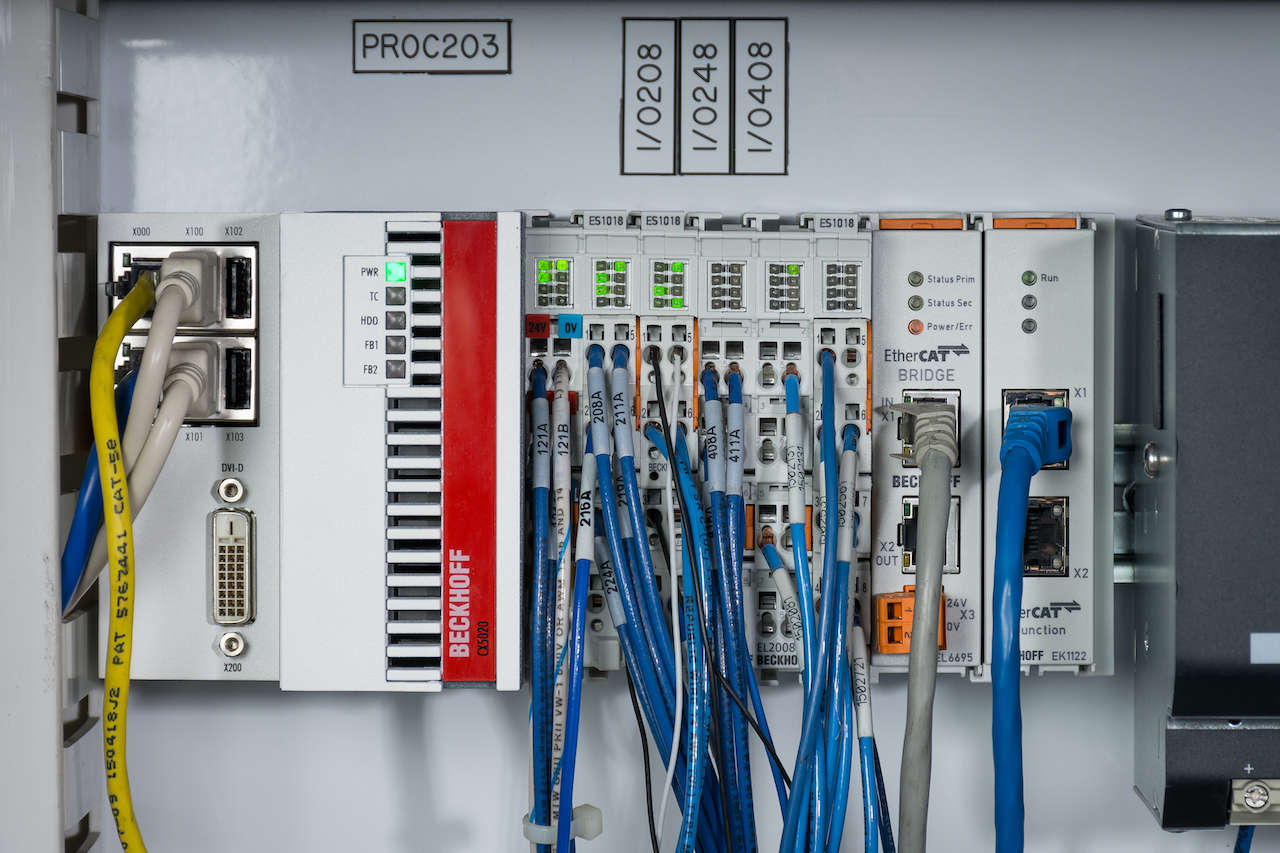
Using scalable Beckhoff Embedded PCs and EtherCAT I/O for the Honeywell Intelligrated Momentum Machine Control (MC4) controls platform provided performance advantages and cost savings. Courtesy: Beckhoff
“The flexible workstations support picking, replenishment or quality control operations, as well as other value-added services, while maintaining a compact footprint,” said Joice, who oversaw GTR development. “Traditionally, an associate would handle the products arriving in totes, but as robotics become more common in the workplace to increase efficiency and offset the shortage of workers, workstations need the flexibility for robots to complete these tasks. Our system transcends those two different inputs.”
The current workstation iteration uses a cell that features an articulated robot equipped with grippers designed for efficient and precise material handling. Shuttles in the automated storage and retrieval system (AS/RS) deliver items either to the robot or operator. To ensure robots can complete all actions, the workstations require automation technologies that integrate with legacy technologies in the warehouse.
At the same time, they need to support the Industrial Internet of Things (IIoT) technologies and increased data acquisition – all underpinnings of a connected infrastructure. Implementing automated processes, such as a GTR, can help customers increase reliability, improve equipment utilization and maximize productivity.
Control architecture of the distribution center
To support today’s intralogistics applications and build a foundation for the future, the control platform required flexible software, hardware and networking technologies. The PC-based solution includes machine control and IIoT-enabled data acquisition to provide key insights for the many offerings of a connected distribution center platform. Most fieldbus and industrial Ethernet technologies experience performance issues when sending large quantities of data and don’t work well in mixed-architecture environments.
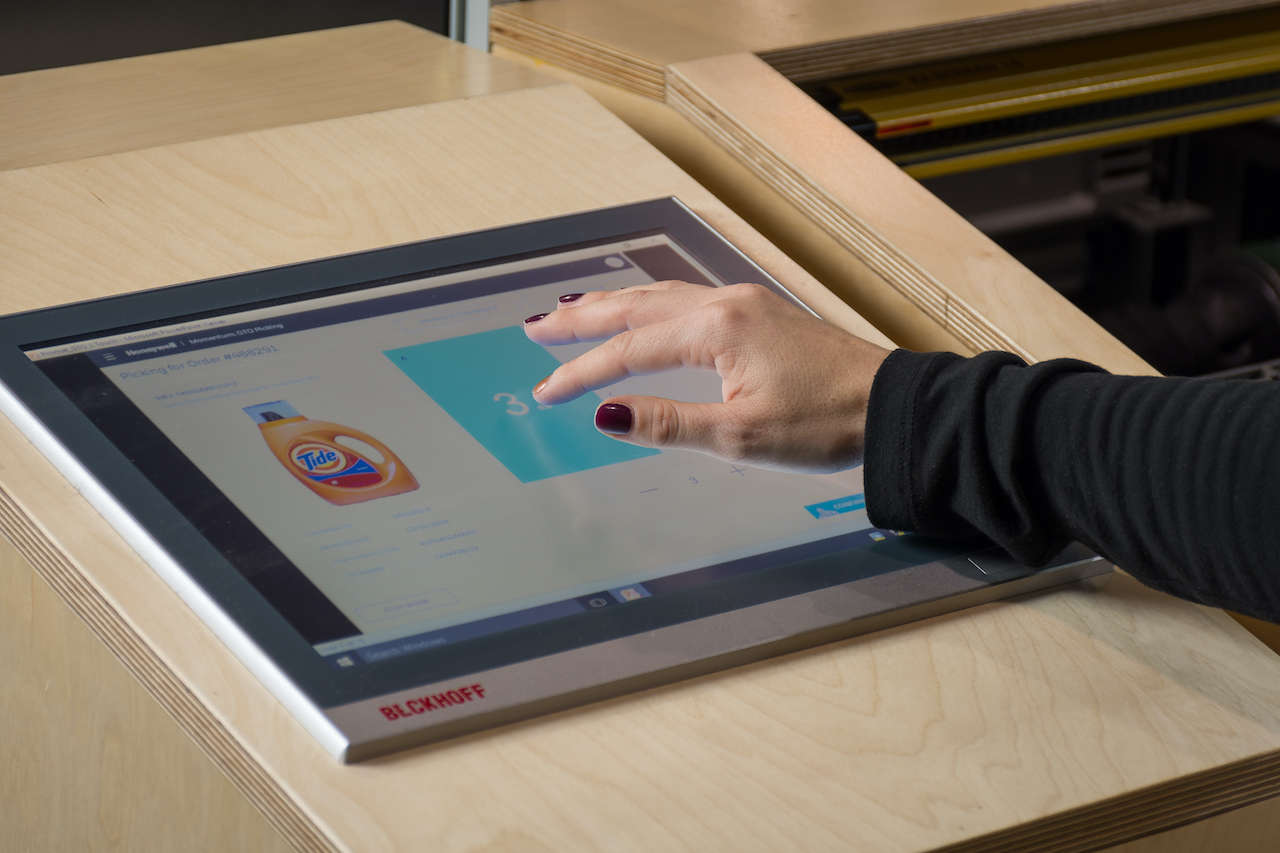
Multi-touch Control Panels from Beckhoff provide the optimal HMI hardware for diverse intralogistics solutions. Courtesy: Beckhoff
“Retrofits comprise a large portion of our business,” Johnson said. “Whether we installed the system or another company did, we have to support a wide range of protocols with open communication.”
Despite already using PC-based solutions from a previous vendor for legacy control platforms, hardware limitations prevented broader implementation of the new PC-based architecture. These hardware offerings did not support distributed control architectures, and they were cost-prohibitive. One server-class solution could not be installed on the warehouse floor and was managed by customers’ IT departments, adding maintenance expenses. Another PC could be installed near the equipment but required expensive, air-conditioned cabinets, isolated from the other components.
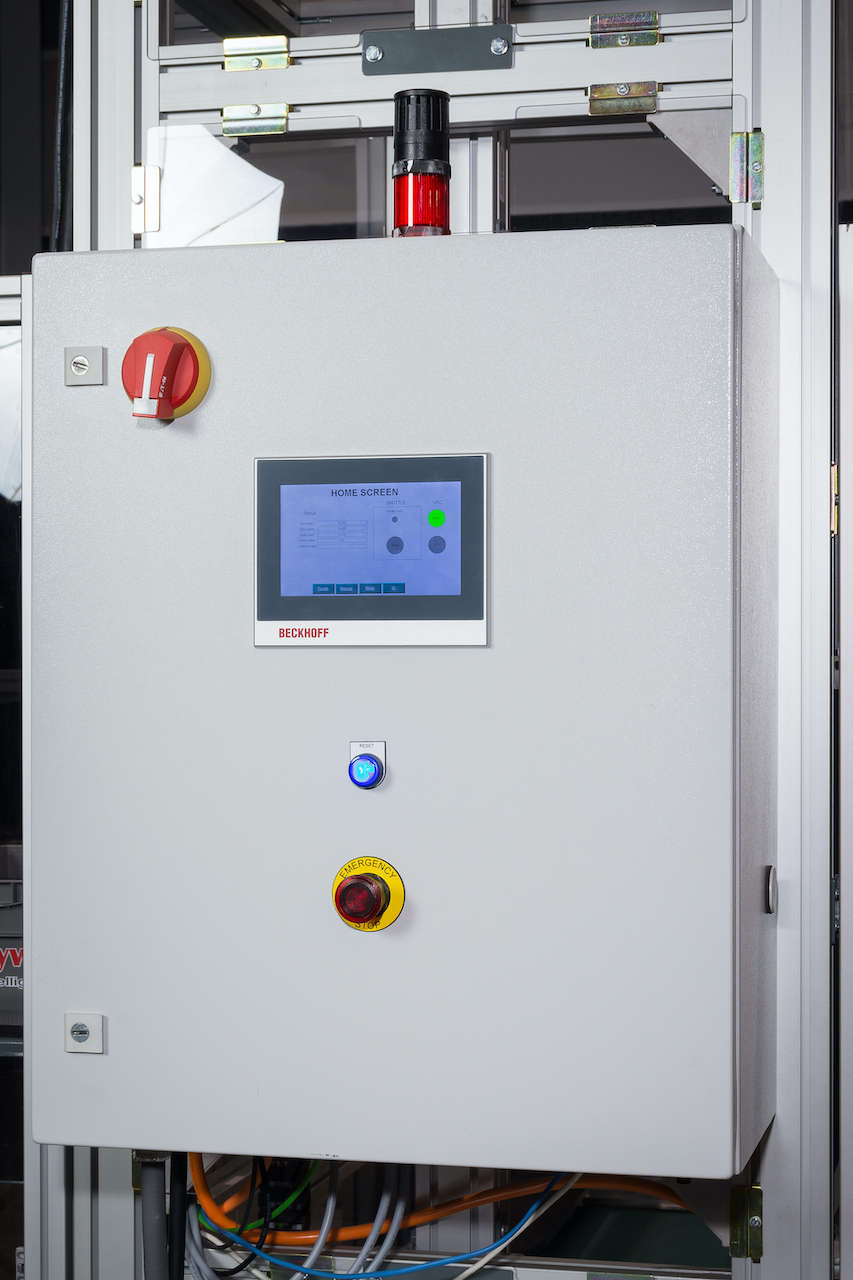
Multi-touch Control Panels from Beckhoff provide the optimal HMI hardware for diverse intralogistics solutions. Courtesy: Beckhoff
Optimizing intralogistics communication with EtherCAT
Johnson and his team evaluated the high-speed, deterministic EtherCAT industrial Ethernet system and related automation technologies. EtherCAT allows systems to connect to DC equipment built on a legacy network, including EtherNet/IP, Profinet, Profibus, DeviceNet and others – with the simple addition of appropriate EtherCAT couplers and gateways.
Johnson said, “We can get significantly more information from field devices without impacting network performance, which helps us achieve the goals of a connected distribution center.”
EtherCAT also enabled more modular designs of the GTR workstations, as well. “EtherCAT helps us keep the cost down per station and also implement future expansion capabilities at a lower cost to the end user,” Joice said.
In addition to EtherCAT I/O modules, distributed EtherCAT Box modules offered the same high-speed communication in an IP67 form factor, making it suited to the GTR and to conveying systems that span across warehouses. The workstations also integrate certified functional safety over EtherCAT (FSoE) communication via the standard network.
“Honeywell highly prioritizes safety – employee safety, equipment safety and environmental safety. The ability to add safety features within the same network that’s already in the field will become more critical,” Joice said.
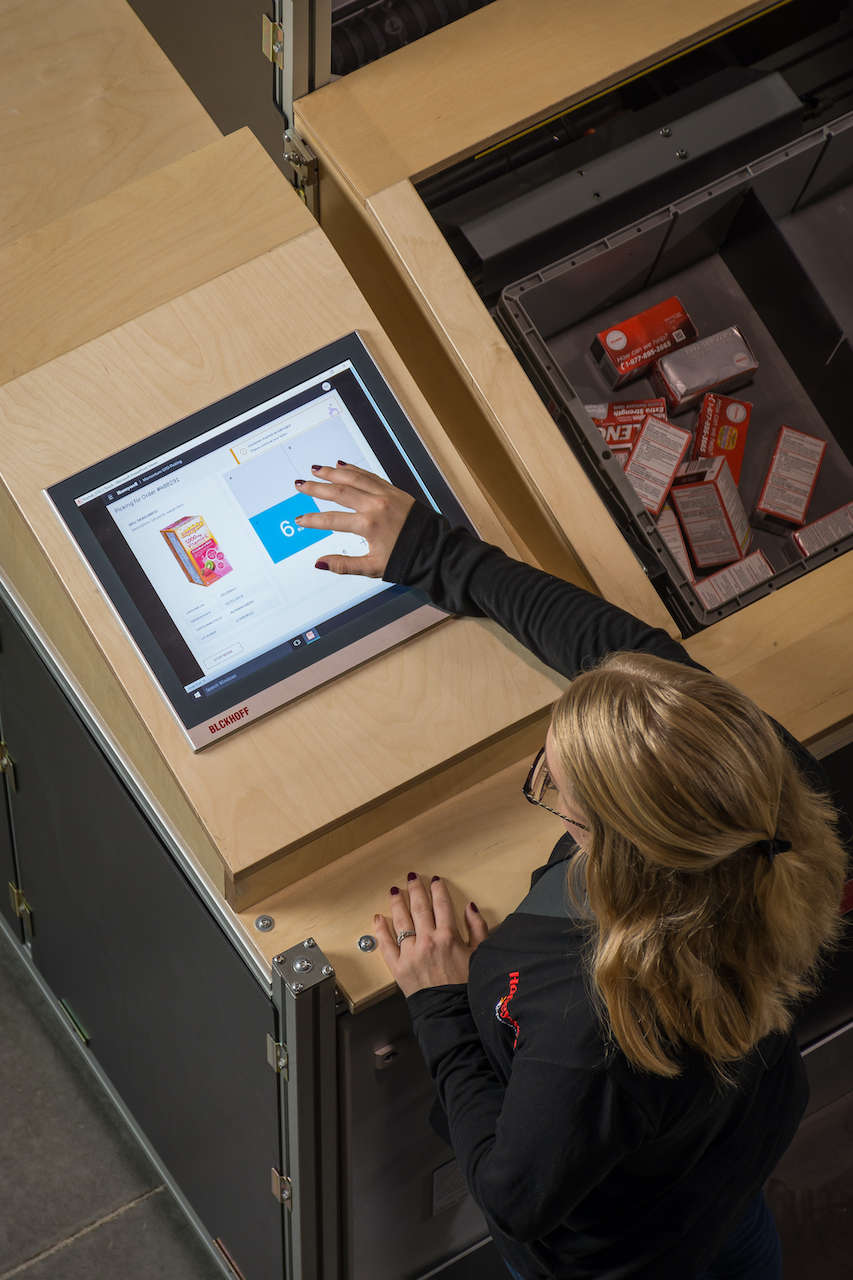
GTO workstations support picking, replenishment or quality control operations with flexible PC-based control and EtherCAT technologies. The workstations also feature TwinSAFE integrated functional safety, which provides certified Safety over EtherCAT (FSoE) communication via the standard network. Courtesy: Beckhoff
Upgrading PC-based hardware and software
While several options were available for the new PC-based architecture, the engineering team has standardized on a series of embedded PCs using quad-core processors.
“The performance capability per dollar spent is optimal, and we don’t have to worry about running out of bandwidth,” Johnson said. “The DIN rail-mounted IPCs are capable in harsh warehouse environments and sit in the same control cabinet as the I/O, drives and other components. As a result, we no longer have to install PC-based controllers in the IT space and also don’t have the added expense of separate cabinets.”
The GTR workstations feature smaller embedded PCs, and the GTO versions for humans also include multi-touch control panels for the operator interface. According to Joice, IPCs and EtherCAT’s open connectivity can boost intralogistics solutions’ capabilities to send feedback from sensors to the cloud or other higher-level systems and visualize performance and production figures in real time.
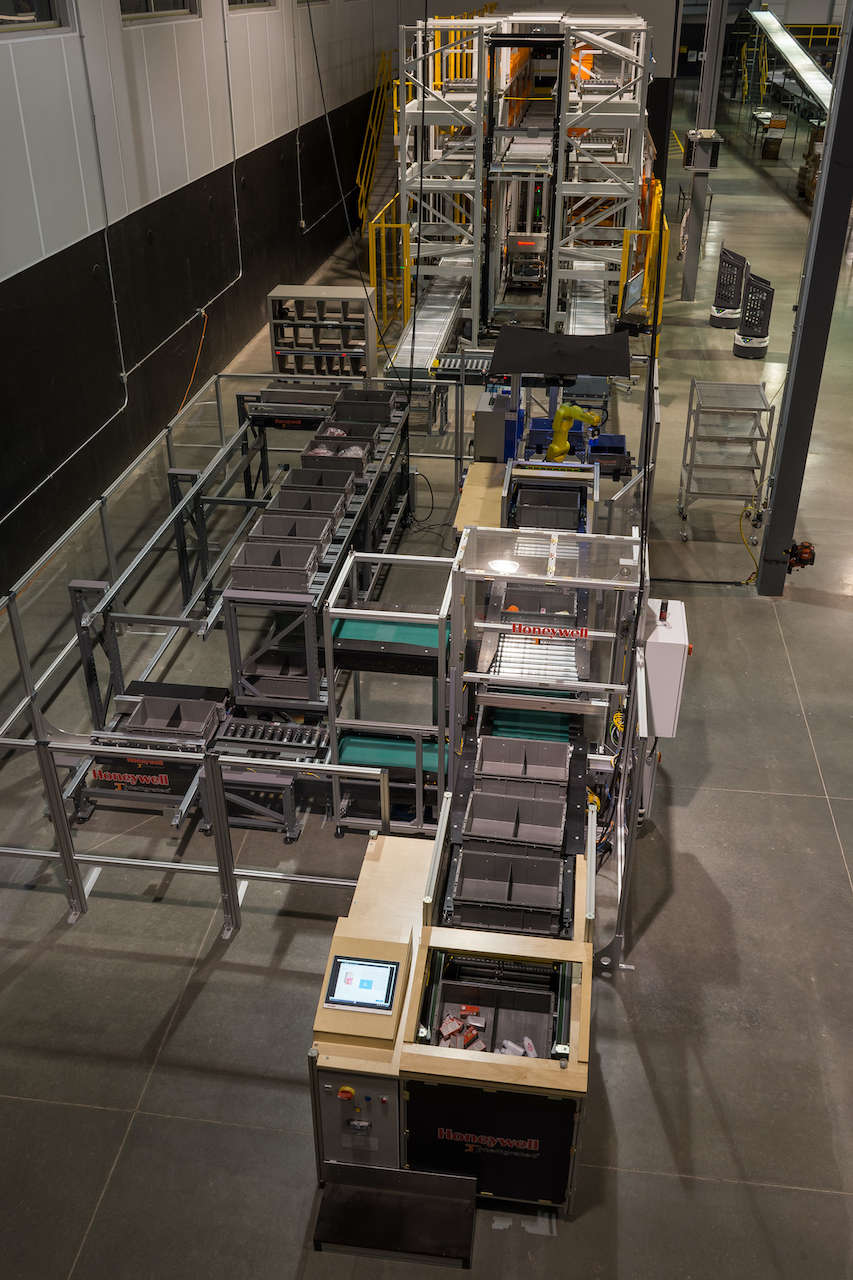
GTO workstations support picking, replenishment or quality control operations with flexible PC-based control and EtherCAT technologies. The current workstation iteration uses a cell provided by Soft Robotics that features an articulated robot equipped with grippers designed for efficient and precise material handling. Courtesy: Beckhoff
“We leverage many IoT components on the marketplace to gather actionable information about our solutions and offer our customers better visibility into those assets,” Joice said.
This flexibility extends to the automation software. The engineering and runtime software packages in the comprehensive software empower engineers to create applications that handle Big Data, pattern recognition and condition or power monitoring, programmable logic controller (PLC) and motion control tasks. The software offers a free selection of IEC 61131-3 programming languages and their object-oriented extensions, computer science languages found in Microsoft Visual Studio, a variety of built-in function blocks and other options in the graphical editor.
The GTR workstations rely on this automation software for real-time control. During system configuration, the designs also benefit from automation device specification (ADS), a device and fieldbus-neutral interface that enables automatic detection and addressing of devices, saving engineering effort.
“All of these features highlight the flexibility of this automation platform and what we offer with our connected DC infrastructure,” Joice said.
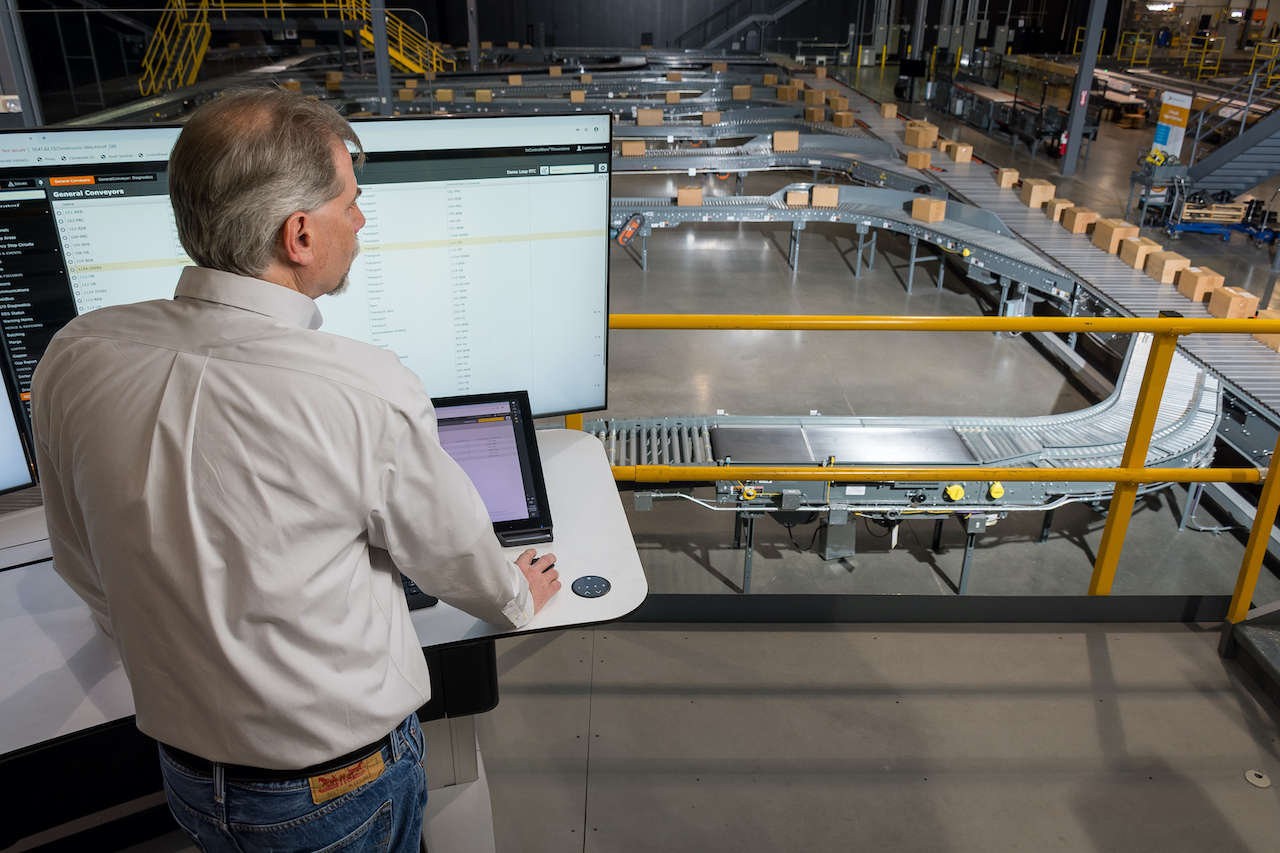
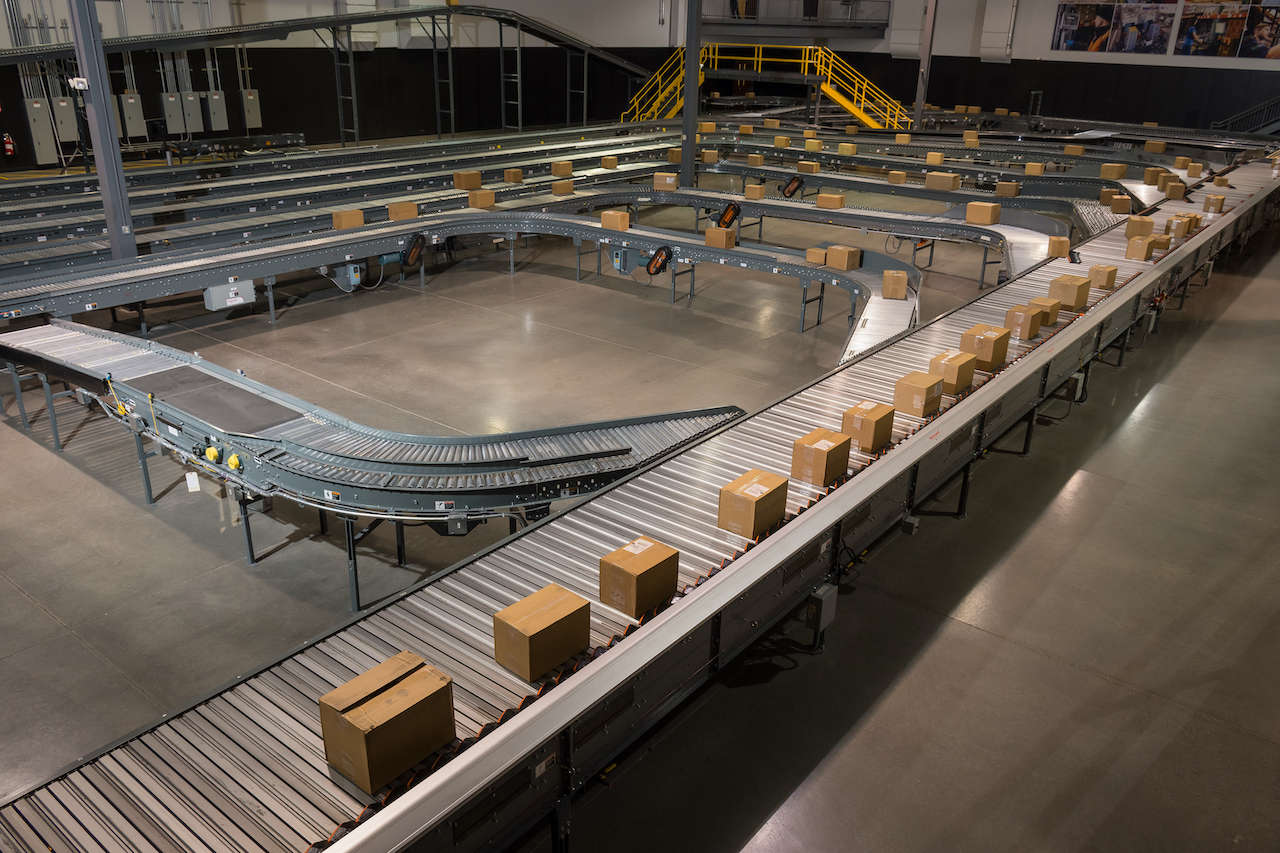
The MC4 PC-based control platform from Honeywell Intelligrated furthers The Connected Distribution Center concept, which connects hardware with KPIs to improve performance, reliability and maintainability. Courtesy: Beckhoff
Effective e-commerce solutions deliver results
Implementing PC-based automation technologies provided several advantages such as increased flexibility, scalability and connectivity. This allowed the company to provide the greater functionality and the data their customers need to help them offset labor challenges and reduce engineering requirements. These advantages, according to Joice, enable the GTR solution to scale up based on demand.
“With the expandable control platform and EtherCAT, we can install a central station and then add on multiple distributed locations for associates or additional robots to increase capacity. That gives ultimate flexibility to our customers, whether it’s a multi-billion-dollar e-commerce company or a start-up trying to increase output for e-commerce, order fulfillment or manufacturing,” Joice said.
For the new PC-based system, these automation solutions prove most reliable and cost-effective, according to Johnson, who has installed more than 80 of this vendor’s IPCs to run in their offering over the past five-plus years without failures … except for “one where an entire cabinet was destroyed by an errant fork truck,” he said. “Since we don’t have to use air-conditioned cabinets or install PCs in the IT space, this IPC technology saved us upwards of 50% in hardware costs, even over PLCs. Our customers like these embedded PCs because they look similar to a PLC. Although some are uncertain about transitioning from legacy PLC technology, they mainly care about performance and uptime. The fact of the matter is: both are industrial-grade machine controllers with an operating system, but unlike hardware PLCs, PC-based control is cost-effective, flexible and transparent.”
Beyond the technological advantages, the system integrator collaborates with the automation vendor’s engineers. Joice said the expertise is crucial during every phase of a project from research and development of new intralogistics systems to commissioning and troubleshooting.
“Our close working relationship with their sales and support engineers offers dynamic collaboration. We both work well together, and they always strive to understand our needs and provide the best solutions to every challenge,” Joice said.
When the machine builder/system integrator collaborates to drive new technology development, it helps meet today’s labor challenges and the evolving technical demands of e-commerce. Through enabling and accelerating digital transformation, the connected offerings continue enhancing performance, reliability and maintainability.
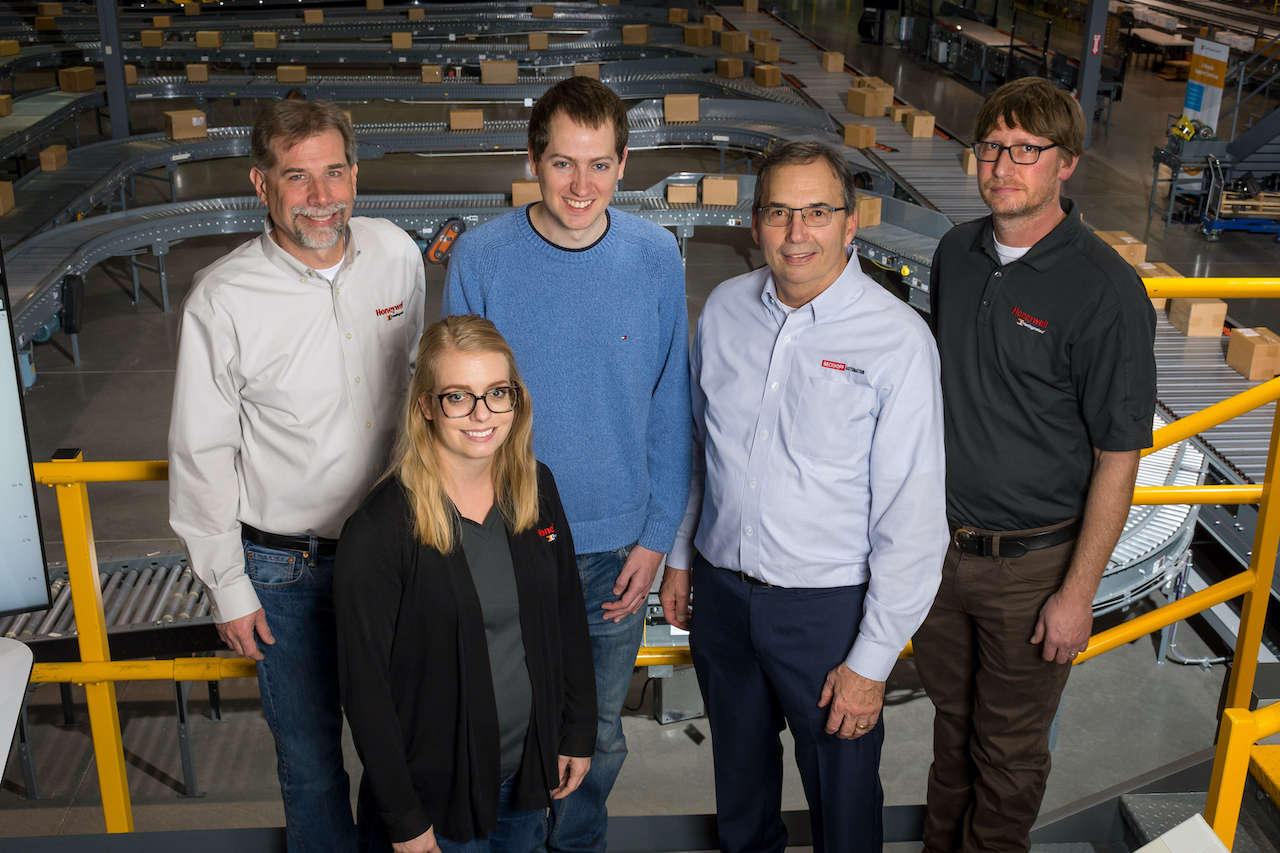
Beckhoff regional sales engineer Mark Mosher (second from the right) works closely with the Honeywell Intelligrated team in Mason, Ohio, including (from left) Jason Johnson, senior manager of machine control development; Kristan Viox, senior marketing coordinator; Alan Smith, software engineering supervisor; and Matt Kramer, senior engineering technician. Courtesy: Beckhoff
James Figy, senior content specialist, Beckhoff Automation LLC. Edited by Chris Vavra, web content manager, Control Engineering, CFE Media and Technology, cvavra@cfemedia.com.
MORE ANSWERS
Keywords: EtherCAT, connected distribution center, system integration
CONSIDER THIS
What benefits could your facility gain from a connected distribution center?
Do you have experience and expertise with the topics mentioned in this content? You should consider contributing to our CFE Media editorial team and getting the recognition you and your company deserve. Click here to start this process.
